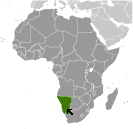World Atlas: Namibia. On this page you can see the map, country flag and many detailed information about the people, history and economy of Namibia.

Here you can find online selected information about the geography, inhabitants, government, economy and history of Namibia. Included are selected statistics, an overview map and the detailed map of Namibia. But let's start with the flag of Namibia here:
Namibia - Overview:
What you should know about Namibia? Let's start with this: South Africa occupied the German colony of South-West Africa during World War I and administered it as a mandate until after World War II, when it annexed the territory. In 1966, the Marxist South-West Africa People's Organization (Swapo) guerrilla group launched a war of independence for the area that became Namibia, but it was not until 1988 that South Africa agreed to end its administration in accordance with a UN peace plan for the entire region. Namibia has been governed by Swapo since the country won independence in 1990, though the party has dropped much of its Marxist ideology. Prime Minister Hage Geingob was elected president in 2014 in a landslide victory, replacing Hifikepunye Pohamba who stepped down after serving two terms. Swapo retained its parliamentary super majority in the 2014 elections and established a system of gender parity in parliamentary positions.
Geography of Namibia
 Where on the globe is Namibia? The location of this country is Southern Africa, bordering the South Atlantic Ocean, between Angola and South Africa. Total area of Namibia is 824,292 sq km, of which 823,290 sq km is land. So this is quite a large country. How could we describe the terrain of the country? This way: mostly high plateau; Namib Desert along coast; Kalahari Desert in east. The lowest point of Namibia is Atlantic Ocean 0 m, the highest point Konigstein on Brandberg 2,573 m. And the climate is desert; hot, dry; rainfall sparse and erratic.
Where on the globe is Namibia? The location of this country is Southern Africa, bordering the South Atlantic Ocean, between Angola and South Africa. Total area of Namibia is 824,292 sq km, of which 823,290 sq km is land. So this is quite a large country. How could we describe the terrain of the country? This way: mostly high plateau; Namib Desert along coast; Kalahari Desert in east. The lowest point of Namibia is Atlantic Ocean 0 m, the highest point Konigstein on Brandberg 2,573 m. And the climate is desert; hot, dry; rainfall sparse and erratic.
Inhabitants of Namibia
Let's take a look how many people live in Namibia. The number is: 2,484,780. So this is not very populous country. Who lives here? black 87.5%, white 6%, mixed 6.5%. What are the languages in Namibia? Oshivambo languages 48.9%, Nama/Damara 11.3%, Afrikaans 10.4% (common language of most of the population and about 60% of the white population), Otjiherero languages 8.6%, Kavango languages 8.5%, Caprivi languages 4.8%, English (official) 3.4%, other African languages 2.3%, other 1.7%. And the religions: Christian 80% to 90% (at least 50% Lutheran), indigenous beliefs 10% to 20%. How old are the people in average? 21.2 years. We have to add that this number is the median - so one half of the people is older than this, one half is younger. And what is their life expectancy (at birth)? This: 64 years. Where the people live in Namibia? Here: population density is very low, with the largest clustering found in the extreme north-central area along the border with Angola. The major urban areas of Namibia are: Windhoek (capital) 368,000 (2015).
Government and Economy of Namibia
The capital of Namibia is Windhoek and the government type presidential republic. Let's take a look at the administrative divisions - 14 regions; Erongo, Hardap, //Karas, Kavango East, Kavango West, Khomas, Kunene, Ohangwena, Omaheke, Omusati, Oshana, Oshikoto, Otjozondjupa, Zambezi; note - the Karas Region was renamed //Karas in September 2013 to include the alveolar lateral click of the Khoekhoegowab language. Regarding the economy of Namibia, important industrial products are meatpacking, fish processing, dairy products, pasta, beverages; mining (diamonds, lead, zinc, tin, silver, tungsten, uranium, copper). Important agricultural products are millet, sorghum, peanuts, grapes; livestock; fish. The most important export commodities are diamonds, copper, gold, zinc, lead, uranium; cattle, white fish and mollusks and the most important export partners are Switzerland 20%, South Africa 17.1%, Botswana 15%, Zambia 6.7%, Spain 4.6%, Italy 4.2% (2016). The most important import commodities are foodstuffs; petroleum products and fuel, machinery and equipment, chemicals and the most important import partners are South Africa 57.1%, Botswana 6.8%, Zambia 4.1% (2016). How rich is Namibia and how rich are people in this country? The most important number here is GDP per capita (PPP): $11,500 (2017 est.). This is quite good. Let's add that this means Gross Domestic Product per person, which is recalculated with respect to the relative cost of local goods and services. And one more important number - population below poverty line: 28.7% (2010 est.).